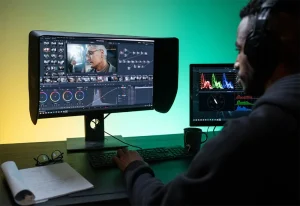To turn your travel footage into a cinematic masterpiece, focus on mastering composition by using the rule of thirds and exploring unique angles. Capture the magic of natural light, especially during the golden hour, to enrich your scenes. Create a compelling narrative with a clear story arc and emotional climax. Enhance your footage with smooth editing transitions and thoughtful sound design. Dive into these techniques further and unlock the secrets to stunning cinematic travel videos.
Mastering Composition and Framing
Composition and framing are crucial elements in transforming your travel footage into a captivating story. Start by considering the rule of thirds, which helps you create balanced and engaging shots. Imagine your frame divided into nine equal parts; place points of interest along these lines or their intersections. Doing so adds depth and interest.
Don’t forget to lead the viewer’s eye. Use leading lines like roads, rivers, or fences to guide attention to the subject. Experiment with different angles to add drama or highlight unique perspectives. Framing your subject with natural elements like archways or trees can also add layers to your scene.
Always keep your horizon straight to maintain professionalism. By mastering these techniques, you’ll create visually appealing travel footage that tells a compelling story.
Utilizing Natural Light to Your Advantage
Natural light is one of your greatest tools in creating stunning travel footage. It adds depth and emotion without the need for artificial setups. To use it effectively, pay attention to the golden hour—shortly after sunrise or before sunset—when the light is soft and warm, casting long shadows and creating a magical atmosphere. Avoid harsh midday light, which can create unflattering shadows.
Position your subject in relation to the light source. Backlighting can create a beautiful silhouette, while side lighting adds texture and dimension. Don’t forget to consider the weather; overcast days can provide a natural diffuser for even lighting. Move around to find the best angles where natural light enhances your scene, turning ordinary moments into cinematic visuals.
Capturing Dynamic Movement and Angles
When capturing dynamic movement and angles in your travel footage, think creatively and be willing to experiment. Don’t just record from eye level—try different perspectives to add depth and intrigue. Get down low or find a high vantage point to provide unique views. Incorporate movement by following subjects, panning, or using a gimbal for smooth tracking shots. Remember, each angle and movement can convey a different emotion or highlight a particular aspect of your journey. Keep your shots varied to maintain audience interest.
- Low angles: Create a sense of power or scale.
- High angles: Offer a comprehensive view of your location.
- Tracking shots: Follow subjects to add flow and continuity.
- Wide shots: Capture the grandeur of landscapes.
- Close-ups: Focus on details that tell a story.
Crafting a Compelling Narrative
To create a cinematic masterpiece from your travel footage, start by defining your story arc to give your project direction and purpose. Develop strong characters that viewers can relate to, ensuring they’re memorable and engaging. Establish emotional connections by weaving in moments that evoke genuine feelings, pulling your audience into the journey with you.
Define Your Story Arc
How do you transform your travel footage into a captivating story that holds the viewer’s attention? Begin by defining a clear story arc. A well-crafted narrative takes your audience on a journey, just as you experienced. Start with a strong opening that sets the stage, then develop a theme or message that resonates.
Consider these tips:
- Identify a Theme: What central idea ties your footage together?
- Build Tension: Introduce conflicts or challenges to engage viewers.
- Create a Climax: Lead up to a memorable, emotional peak.
- Resolve the Story: Provide closure, leaving viewers satisfied.
- Reflect on the Journey: End with a takeaway or lesson learned.
Develop Strong Characters
Someone once said that characters are the heart of any story, and your travel footage is no exception. To captivate your audience, focus on developing strong characters. Whether it’s a local guide, a fellow traveler, or even yourself, showcase their unique traits and motivations. Capture candid moments that reveal their personalities and bring them to life on screen.
Think about what makes these individuals intriguing. Is it the way they navigate bustling markets or their passion for hidden landscapes? Highlight their quirks and challenges to create depth. Use interviews or voiceovers to share insights about their journey and goals. Remember, a well-rounded character adds layers to your narrative, transforming your travel footage into a story that resonates with viewers.
Establish Emotional Connections
Characters form the backbone of your story, but establishing emotional connections truly breathes life into your travel footage. Viewers need to relate to your journey, feeling the pulse of each moment. To achieve this, dive deep into emotions, whether it’s joy, wonder, or melancholy. Make your audience feel like they’re traveling alongside you, experiencing the highs and lows of each destination.
- Share personal anecdotes****: Reveal how a place or person impacted you.
- Capture genuine reactions****: Show authentic moments, not staged ones.
- Highlight local interactions****: Showcase the people you meet and their stories.
- Use evocative music****: Choose a soundtrack that complements the emotions.
- Focus on details: Zoom in on expressions, gestures, and settings that tell a story.
These elements transform your footage into a compelling narrative.
Enhancing Your Footage With Expert Editing Techniques
To elevate your travel footage, focus on mastering smooth transitions and color grading essentials. These techniques can transform simple clips into a cohesive visual story that captivates your audience. By blending scenes seamlessly and enhancing colors, you’ll create a professional look that enhances the overall narrative.
Mastering Smooth Transitions
Though raw travel footage can capture breathtaking landscapes and vibrant cultures, mastering smooth transitions transforms these clips into a seamless cinematic experience. You’ll want your audience to feel like they’re journeying alongside you, and smooth transitions make that happen. Start by planning your shots with transitions in mind. When editing, use cuts and fades to maintain fluidity. Don’t overuse effects; subtlety is key. Match your transitions to the rhythm of your soundtrack, creating a cohesive mood. Use these techniques:
- Match cuts: Align similar visuals to create a seamless flow.
- Cross dissolves: Gently blend one scene into the next.
- Motion transitions: Use camera movements to guide the eye naturally.
- L-cuts and J-cuts: Overlap audio to connect scenes.
- Speed ramps: Adjust speed to highlight key moments.
Color Grading Essentials
Color grading is the magic wand that transforms your travel footage from ordinary to extraordinary. It enhances colors, adjusts mood, and brings out the essence of your journey. Start by choosing the right software—DaVinci Resolve or Adobe Premiere Pro are great options. Dive into your footage, adjusting the white balance to ensure natural tones. Enhance contrast to make your visuals pop, but be careful not to overdo it. Use color wheels to refine shadows, midtones, and highlights, giving your scenes depth. Experiment with LUTs (Look-Up Tables) to apply professional-grade color palettes. Always keep your destination’s vibe in mind; a beach scene might need warm tones, while a mountain adventure could benefit from cooler hues. Practice makes perfect, so keep experimenting!
Incorporating Sound Design for Immersive Experiences
While visual storytelling captures the essence of your travel adventures, incorporating sound design elevates your footage to a new level of immersion. Sound breathes life into your visuals, making viewers feel like they’re part of your journey. To achieve this, focus on layering ambient sounds, music, and effects that complement your scenes. Here’s how you can enhance your travel footage with sound design:
- Capture Authentic Ambient Sounds: Record natural sounds on-site to bring your locations to life.
- Curate a Fitting Soundtrack****: Choose music that matches the mood and tone of your footage.
- Use Sound Effects** Sparingly**: Add subtle effects to highlight specific moments without overpowering the scene.
- Balance Audio Levels: Ensure dialogue, music, and effects are harmonious.
- Invest in Quality Microphones****: Good audio equipment captures clearer sounds.
Frequently Asked Questions
What Equipment Is Essential for Capturing High-Quality Travel Footage?
To capture high-quality travel footage, you’ll need a reliable camera, sturdy tripod, portable microphone, and versatile lenses. Don’t forget extra batteries and memory cards. These essentials ensure you’re prepared for any spontaneous or planned moments on your adventures.
How Can I Stabilize My Footage While Filming on the Go?
You can stabilize your footage by using a gimbal or handheld stabilizer. Keep your movements smooth and steady. Practice the ninja walk technique to reduce shake. Consider using software for post-production stabilization if necessary.
What Are Some Tips for Shooting in Low-Light Environments?
To shoot in low-light environments, use a fast lens with a wide aperture, increase your ISO carefully, and keep your camera steady. Take advantage of available light sources and consider using a portable LED light for extra illumination.
How Do I Protect My Camera Gear During Extreme Weather Conditions?
You should use waterproof bags and cases to shield your camera gear during extreme weather. Keep silica gel packs handy to absorb moisture, and always dry equipment thoroughly after exposure. Don’t forget lens hoods to minimize rain impact.
Are There Any Legal Considerations When Filming in Foreign Countries?
When filming abroad, you must check local laws and obtain necessary permits. Some countries have restrictions on drones or specific locations. Research thoroughly to avoid fines or legal issues, ensuring your footage is captured legally and responsibly.


